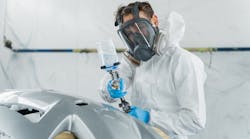When building your workplace SOPs, always keep focus on the fact that your procedures should reduce waste, increase workplace efficiencies and streamline work processes. Reviewing the two previous SOP installments, we looked at how this attention to detail in the management of your production processes addressed these three essential business elements.
It is important to also mention that during the SOP building process, you will want to look around your store and see if there are unnecessary or unwanted items or “clutter” that can be removed. This is considered waste. In future installments we will discuss the relationship between maximizing production efficiencies and the cleanliness of the workplace.
So let’s do a quick review of the key areas of developing the SOP before we begin.
1. Clearly identify what needs to be done.
2. Notify those responsible for a particular work product what their tasks are.
3. Provide information relative to the proper completion of the tasks.
4. What are the documentation requirements?
5. Identify proper tools and equipment.
6. Identify and establish quality control requirements.
7. Identify inspection requirements before release to the next repair technician.
Each operation within the business has a “best practice” performance standard. In other words, there is a right way to do the job so that it is done exactly as intended, reducing any margin for error and ensuring that the job or tasks can be performed consistently and repeatedly. Why? We want to build predictability into the work processes, which allows for a standard of time to be assigned to the task. This enables us both to measure proficiency in the task and to develop an efficiency measurement that validates clocked versus billed hour rates. These are used to determine the productivity and the financial value placed on the activity.
Anything that can be eliminated from the task list that is identified as unnecessary or waste should be removed. This determination is made by examining the process, identifying essential process elements and removing unproductive tasks. It may include combining several tasks to achieve the same net result while eliminating a step. As long as productivity increases and quality improves, the decision will be supported by the result.
This process should be followed whenever a task list is developed. The task list is the precursor to the SOP. The tasks will be identified; then the order in which they are required to be performed will be your procedural steps. Added to that will be necessary tools, equipment and environmental and human needs, all of which will be included in the SOP development. But not all of our daily activities are centered on traditional production steps. We may need to prepare for production. That means preparing the employees for the steps they will encounter in preparing to begin production. That will involve meeting to discuss expectations, cover production SOPs, and establish production indicators such as signs or other visual aids. To begin we will look at the production meeting and some of the required steps in providing detailed information.
Planning and Execution of a Production Meeting
| Daily Shop Meeting |
| 1. Pre-meeting: Print and review vehicle status, vehicle promise date, ordered parts, and back-ordered parts reports. |
| 2. Meeting and schedule times: Meeting to be conducted daily by production manager. Shop owner conducts if production manager absent. Begin morning meeting at 7:45 a.m. And midday meeting at 12:30 p.m. Meeting to be completed within 15 minutes. |
| 3. Daily staffing: Determine staffing for the day. Reassign staff, if required. |
| 4. Scheduled delivery: Review status of all vehicles scheduled for delivery. Identify known obstacles on all vehicles. Identify initial solutions to obstacles. |
| 5. Vehicle status: Record status of all vehicles. Determine if there are known obstacles on all vehicles. Identify initial solutions to each known obstacle. |
| 6. Vehicles arrived: Review status of each vehicle that has arrived. Assign staff to prepare estimate/repair plan. Identify any timeframes required for estimate/repair plan preparation. |
| 7. Vehicle pick up and delivery: Identify any vehicles that need to be picked up or delivered. Assign staff as required. |
| 8. Post-meeting: Update management system status report on all vehicles. Solve known obstacles on all vehicles. Update vehicle owners on vehicle status. |
This is an example of a completed SOP developed for a daily meeting in a collision repair store. It provides all the detail required for conducting a meeting that will provide all the necessary information used on the production floor. We will dissect it so that it will be easier to see who, what, why, where and how the process of developing the SOP culminates in a completed process.
It begins with preparation.
1. Pre-meeting
Tasks included in the “pre-meeting” include:
- Printing and reviewing:
- Vehicle status reports
- Promise dates
- Parts ordering
- Back ordered parts reports
These series of tasks are completed so that the person who will be conducting the meeting has all the discussion topics clearly identified, eliminating the chance of “scope creep” or movement away from the pre-identified topics. This will keep meetings shorter in length and provide information necessary to improve production. The goal is to reduce waste, so begin well prepared for the meeting.
2. Meeting schedule and time
Meetings should be conducted at the same time, in the same place and preferably by the same person each time they are held. This brings a consistency to the process and removes any possibility of having multiple approaches determined by multiple managers, undermining the process. It is extremely important for the manager to begin and end meetings each time, on time. Be sure that the topics are thoroughly covered but “get to the point.” This is production time so limit the time away from work.
3. Daily staffing
When there is a need for a change in work assignments, identification of particular areas of damage, potential repair concerns, vehicle repair sequencing, or other aspects of production, it is vital to production efficiencies that it/they are identified early in the process and communicated clearly during the meeting. That way clarity can be provided. If the discussion involves a particular vehicle or operation, the reassigned tech will have all the necessary change information. This includes disassembly and repair planning processes. It may be necessary to bring a newly delivered vehicle in prior to inventory to meet hourly schedules. That should be decided pre-production.
4. Scheduled delivery
The manager should walk through each vehicle’s status to identify any barriers to completion and any supplemental needs, and to establish if the vehicle is in fact on target for completion. If any obstacles are identified, solutions or corrective action should be immediately identified and put into place once the meeting concludes. If this involves a change in delivery date, customer notification should be completed as soon as the meeting concludes. This should include any file documentation that will need to be made to justify the delay for future reference.
5. Vehicle status
The manager will document the meeting worksheet to record the status of each vehicle as they are reviewed. If an obstacle to completion has been identified, the manager should identify the corrective action and assign that to the person responsible for it; for example, if it is a part issue, provide specific instructions including timeframes for the part to be ordered, mirror matched and provided to the repairing technician. With a solution identified, the timeframe should be adjusted and preparation for the next meeting should include follow-up on the concern, the solution and noting a successful conclusion. For newly arrived vehicles, this may include supplement identification prior to or during disassembly. Vehicle status will be the most discussed but not the only topic covered at these meetings. Use these as opportunities to communicate any changes that may go on in the store as well as updates on materials and procedures.
6. Vehicles arrived
As part of the meeting planning and preparation, the manager will include the vehicles that are in line next for production. It is important to note that planning, scheduling and bringing the vehicle in should be done in a specific order. The disassembly process, who will be responsible for it and who will complete the repair plan are all part of this process. That creates an environment where everyone that is involved in the production process has a clear understanding of the expectations for production prior to the conclusion of the meeting. If a concern is identified, it can be handled during the meeting, keeping the possibility of production stoppage minimized.
7. Vehicle pick up and delivery
During the meeting when vehicles are identified as soon to be completed during the status review, assignments for the vehicles to go to clean-up and delivery are identified. The manager should take all completed or nearly completed information and move that information to their deliver status board for the clean-up department to be able to identify the next vehicle in their production line and any special needs, and to make sure that the final step quality control has been completed by the reassembly staff.
8. Post-meeting
Meetings always end with the documentation of the management system if the shop is so equipped or an entry into the manager’s workbook. This ensures that any situations that were identified during the meeting process are cataloged for use at a later date whether it be for employee growth and opportunity or for tracking obstacles so they don’t occur in the future. The importance of the meeting is to improve productivity, limit or eliminate waste, identify any obstacles to production and keep the employees, and more importantly the customer, informed during the repair process.
The seven key areas for development of SOPs have been followed in this example. Most production situations are similar and use many of the same steps. Additionally, slightly varied approaches could have been used here in both development and execution. These become apparent as new SOPs are identified. The important factors are identification, communication and documentation. If these are used throughout SOP or work standard development, the two important factors, consistency and repeatability, will always be met. This provides the employees with the knowledge that work factors and work product requirements will always remain consistent. A continuous improvement process will always be used and management will always work with them to eliminate obstacles when encountered. The communication will be open and meetings held to reinforce the SOP objectives.

